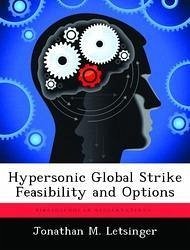This paper explores the feasibility of hypersonic weapons and aircraft as global strike options in the 2035 timeframe. The paper proposes there are currently two limitations or gaps in U.S. prompt global strike capabilities; timeliness, and increasingly the ability to gain access to the highly-defended target area. Additionally, the USAF has a long history of using advanced technology to stay ahead of the threat defense systems and gaining access to target sets, and by 2035, anti-access and area denial (A2/AD) technologies will increasingly threaten the USAF ability to hold any target on the globe at risk. Therefore, given the fact that technologies will continue developing to diminish and deny the advantages of stealth and space assets, could speed once again allow access to denied, heavily defended targets and close the gap for prompt global strike by 2035? The analysis begins with a brief overview of past hypersonic programs and reveals the lack of coherent government policy or USAF confidence in future military utility for hypersonic weapons or aircraft.
Hinweis: Dieser Artikel kann nur an eine deutsche Lieferadresse ausgeliefert werden.
Hinweis: Dieser Artikel kann nur an eine deutsche Lieferadresse ausgeliefert werden.








